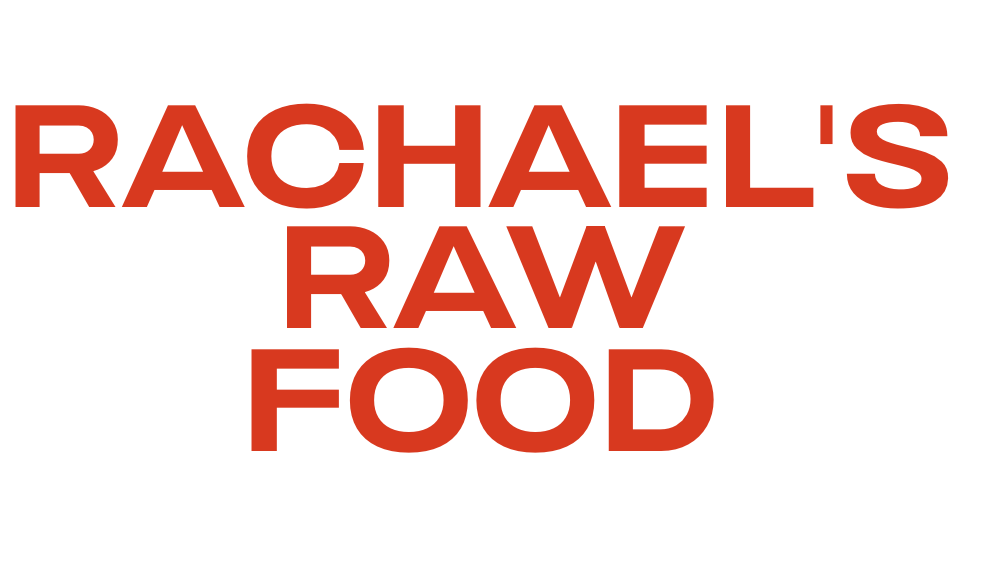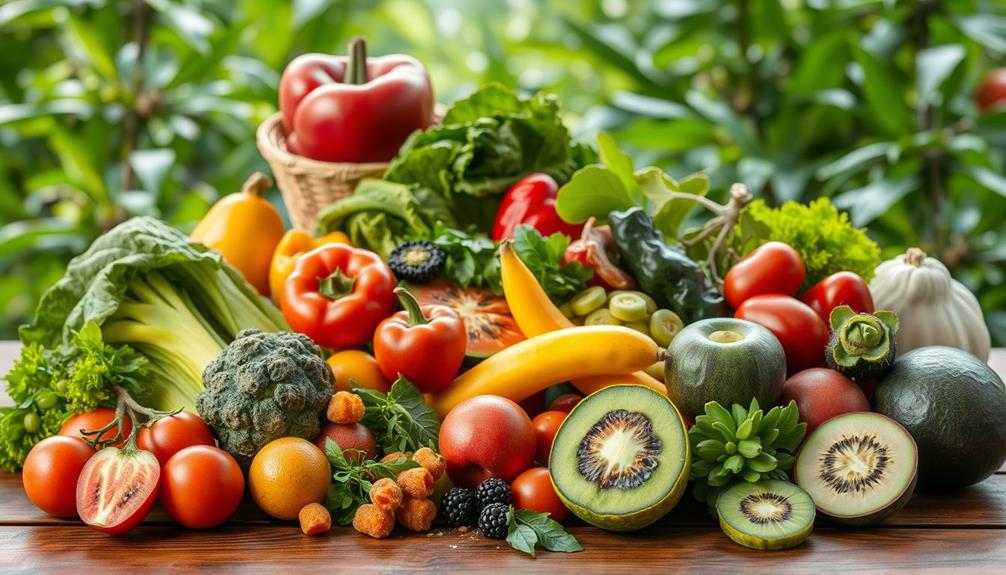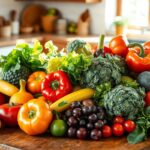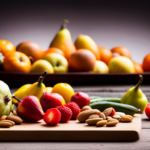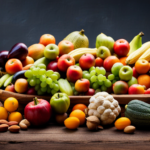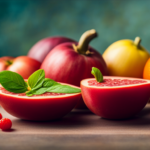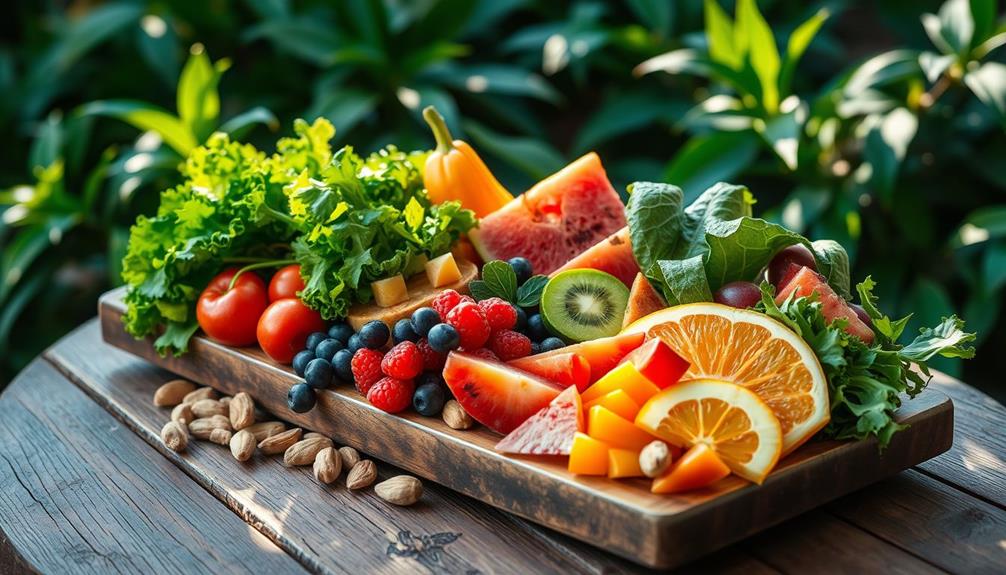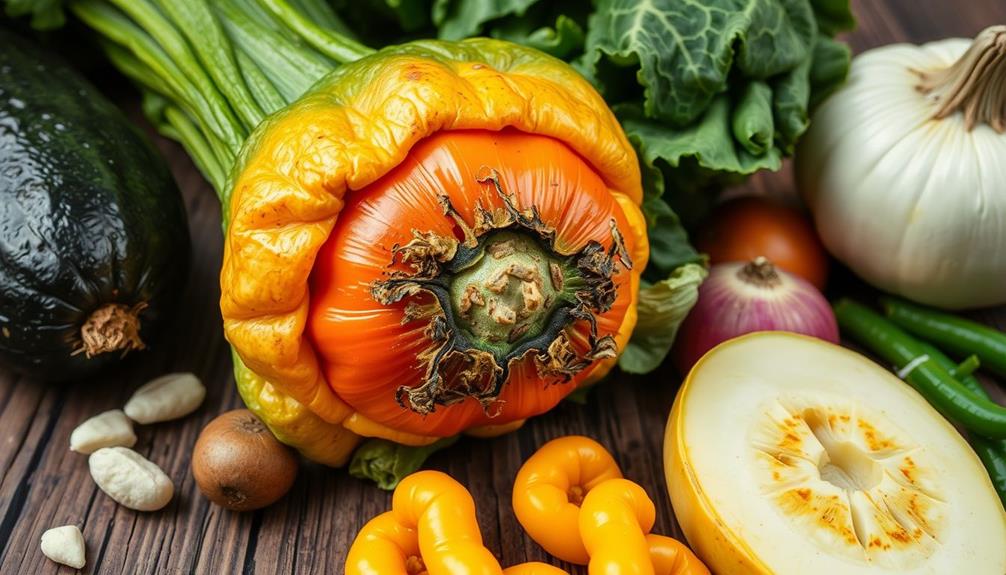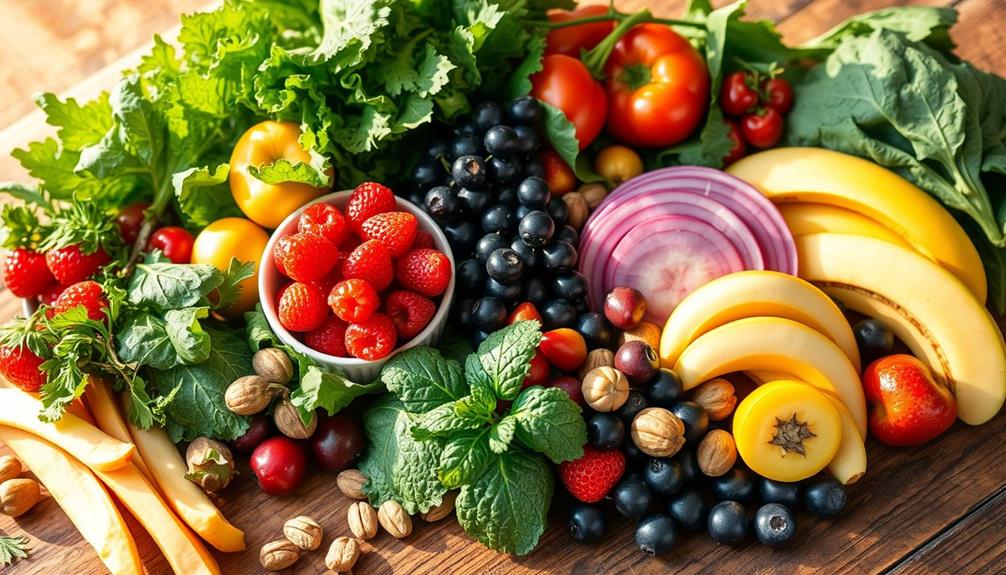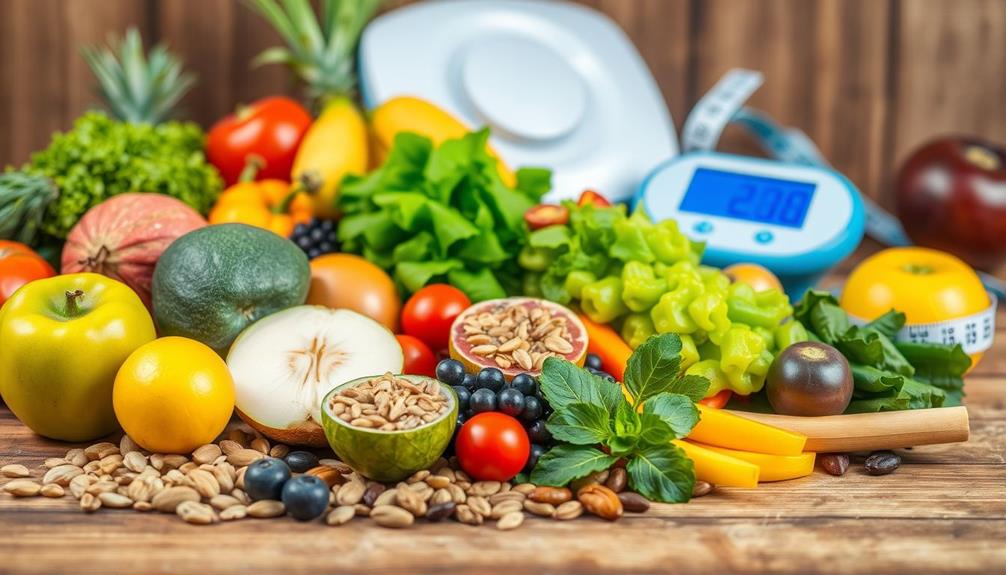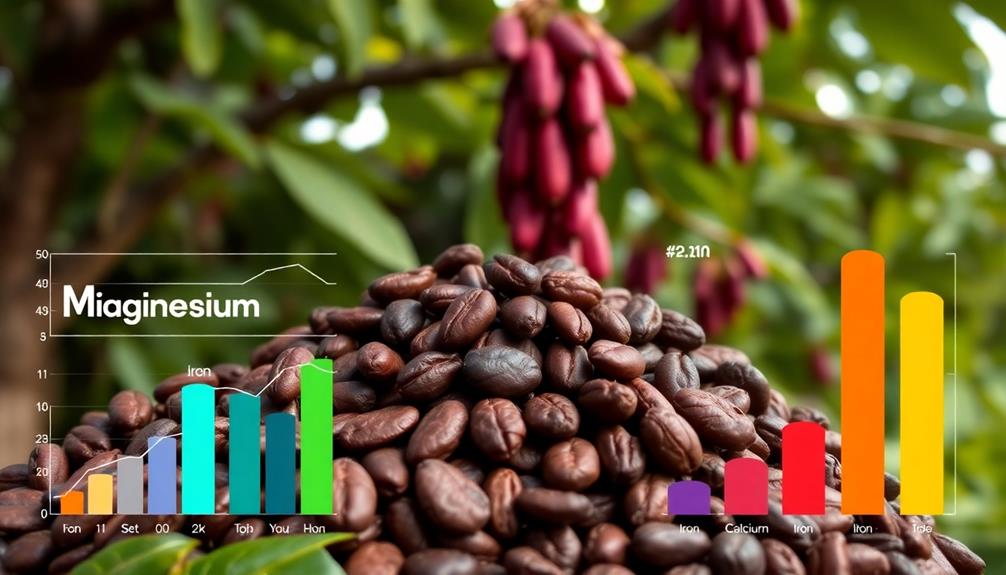Eating raw food can boost your health by increasing your intake of vitamins, minerals, and antioxidants. You'll enjoy enhanced digestion from the fiber content and may even experience improved energy levels and weight loss. However, be aware of potential nutrient deficiencies, especially in vitamin B12, iron, and omega-3 fatty acids, which could affect overall well-being. It's essential to handle raw foods safely to avoid harmful bacteria and consider a balanced approach to optimize nutrient absorption. If you want to explore the various impacts and tips for succeeding on a raw food diet, there's plenty more to uncover.
Key Takeaways
- Eating raw food preserves essential nutrients, enhancing overall health and reducing the risk of chronic diseases like heart disease and diabetes.
- A raw food diet is high in fiber, promoting digestive health, regularity, and improved satiety, which can aid in weight management.
- There are potential nutritional deficiencies, particularly in vitamin B12, calcium, and omega-3 fatty acids, requiring careful planning and possible supplementation.
- Raw foods can harbor harmful bacteria, posing food safety risks, especially for vulnerable populations like pregnant women and young children.
- Balancing raw and cooked foods optimizes nutrient intake, as cooking can enhance the absorption of certain nutrients while retaining others.
Overview of Raw Food Diet
The raw food diet is a vibrant approach to nutrition that emphasizes uncooked and unprocessed foods like fruits, vegetables, nuts, seeds, and sprouted grains. This diet focuses on preserving natural nutrients and enzymes through preparation methods such as blending, juicing, soaking, sprouting, and dehydrating foods at temperatures below 118°F (48°C).
By sticking to uncooked foods, you're aiming to enhance your intake of vitamins, minerals, and antioxidants while minimizing processed foods and added sugars. Additionally, incorporating raw foods like celery juice can provide anti-inflammatory benefits and promote hydration.
However, while the raw food diet can improve overall diet quality and digestive health, it does come with potential risks. You might face nutrient deficiencies, particularly in vitamin B12, iron, and omega-3 fatty acids. That's why careful planning is vital if you decide to follow this diet long-term.
It's important to evaluate supplementation or alternative sources for these nutrients to maintain a balanced intake.
Ultimately, the raw food diet encourages you to embrace whole, natural foods, which can lead to a healthier lifestyle. By being mindful of what you eat, you can maximize the benefits while minimizing the risks associated with a restrictive eating pattern.
Health Benefits of Raw Foods
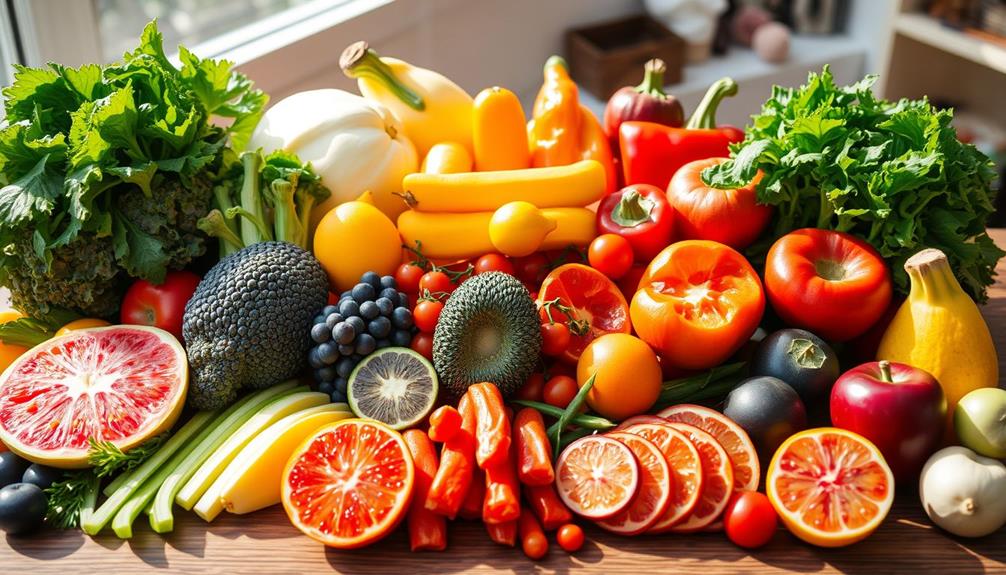
Eating raw foods helps you preserve crucial nutrients that can enhance your overall health. These foods are often rich in essential vitamins and minerals that can boost your immune system and support various bodily functions.
By including more raw fruits and vegetables in your diet, you'll also boost your digestive health thanks to their high fiber content, which can aid in maintaining a healthy gut. This combination can lead to better digestion and increased energy levels, making you feel your best.
Additionally, incorporating essential oils for respiratory health can further enhance your overall wellness.
Nutrient Preservation Benefits
Raw foods offer significant nutrient preservation benefits that can enhance your overall health. By consuming raw fruits and vegetables, you're retaining a wealth of vitamins, minerals, and antioxidants that might be lost during cooking. Water-soluble vitamins, in particular, are preserved in their natural state, ensuring you receive their full health benefits. This high nutrient content can improve skin health and boost your energy levels.
Additionally, incorporating herbal teas like chamomile and ginger can complement a raw food diet, as these teas are known to alleviate discomfort and promote relaxation herbal teas for relief.
Furthermore, a diet rich in raw foods may lower your risk of chronic diseases. Research shows that diets high in fruits and vegetables are associated with reduced incidences of heart disease and diabetes. By focusing on raw foods, you're likely eliminating processed options and added sugars, which can lead to improved overall diet quality. This dietary shift can also contribute to lower blood triglyceride levels.
Moreover, the high fiber content in raw foods aids digestion and promotes satiety, which can facilitate weight loss by providing lower calorie density. By choosing raw foods, you're not just enjoying their vibrant flavors; you're also embracing a lifestyle that prioritizes nutrient preservation, maximizing the health benefits for your body.
Enhanced Digestive Health
Incorporating raw foods into your diet can greatly enhance digestive health. These foods, especially fruits and vegetables, are packed with dietary fiber, which promotes regular bowel movements and helps prevent constipation. A fiber-rich diet not only keeps your digestive system running smoothly but also supports your overall well-being.
Furthermore, different brewing methods, like the French press coffee, can impact the health benefits of your beverages, potentially complementing a diet rich in raw foods.
The high water content in many raw foods aids in hydration, further supporting the digestive process. Proper hydration is essential for ideal digestion, allowing your body to break down and absorb nutrients effectively.
In addition, raw foods often contain natural enzymes that assist in digestion, making nutrients more accessible to your body.
Eating a diet rich in raw foods has also been linked to a healthier gut microbiome. A diverse gut microbiome plays a vital role in digestion and overall health, contributing to better nutrient absorption and immune function.
Additionally, the increased intake of antioxidants from raw foods helps reduce inflammation in the digestive tract, promoting better digestive health and function.
Nutritional Risks of Raw Diet
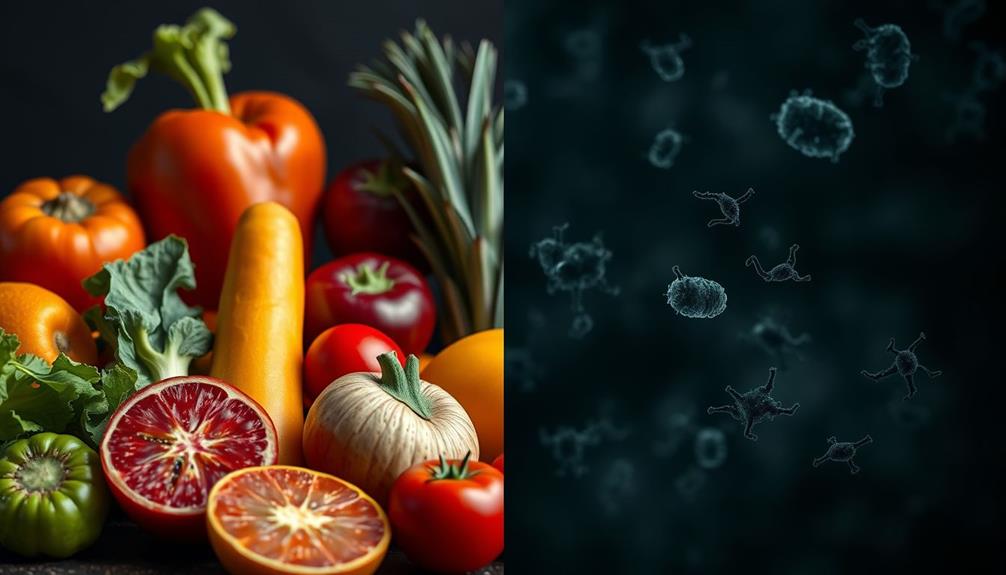
When you follow a raw food diet, you might miss out on essential nutrients like vitamin B12, iron, and omega-3 fatty acids.
This restrictive approach can also limit your protein sources, which is vital for muscle maintenance.
Additionally, certain raw foods can lead to digestive issues or foodborne illnesses if not handled properly, highlighting the importance of understanding cold medications overview when considering health impacts.
If you're not careful with your planning, you could face significant nutritional risks.
Nutrient Deficiencies Risks
Adopting a raw food diet can greatly increase the risk of nutrient deficiencies. Since this diet often excludes animal products and cooked foods, you might find yourself lacking essential nutrients like vitamin B12, calcium, and omega-3 fatty acids.
Additionally, some pet care guides recommend a well-rounded diet for pets to avoid similar deficiencies, highlighting the significance of proper nutrition (Ultimate Hamster Care Guide). Vitamin B12 is especially essential for nerve function and red blood cell production, and without it, you could experience fatigue and neurological issues.
Moreover, insufficient calcium intake can lead to lower bone mass, increasing your risk of fractures over time. The absence of omega-3 fatty acids, typically found in fish, can affect heart health and brain function.
While you may consume plant-based protein sources, they often lack complete amino acid profiles, which are important for muscle maintenance and repair. The restrictive nature of a raw food diet can also lead to inadequate caloric intake, leaving you feeling tired and potentially setting the stage for further nutrient deficiencies.
To combat these risks, you might need to think about supplementation, particularly for vitamin B12, to help maintain your overall health while following a raw food lifestyle.
Protein Source Limitations
A raw food diet can severely limit your protein sources, making it challenging to meet your body's essential amino acid needs. Many plant-based foods don't provide all the essential amino acids necessary for muscle maintenance and overall health.
For instance, while fruits, vegetables, and grains are staples, they often fall short in protein intake. Raw spinach and broccoli, for example, contain only about 2-3 grams of protein per 100 grams, a stark contrast to higher-protein animal products. Additionally, incorporating balanced diet rich in fruits and vegetables is crucial for overall health, but relying solely on raw foods may hinder nutritional balance.
If you don't plan your meals carefully, you might struggle to obtain adequate amounts of vitamin B12, iron, and omega-3 fatty acids, leading to potential deficiencies. Long-term adherence to a raw food diet can contribute to decreased muscle mass and impaired metabolic function, primarily due to insufficient protein from quality sources.
To combat these limitations, supplementation or strategic pairing of raw foods is necessary. Combining legumes with grains can help you achieve a complete amino acid profile, allowing you to maintain adequate protein levels.
Without these strategies, you'll likely find it increasingly difficult to support your health and wellness on a raw food diet.
Food Safety and Raw Foods
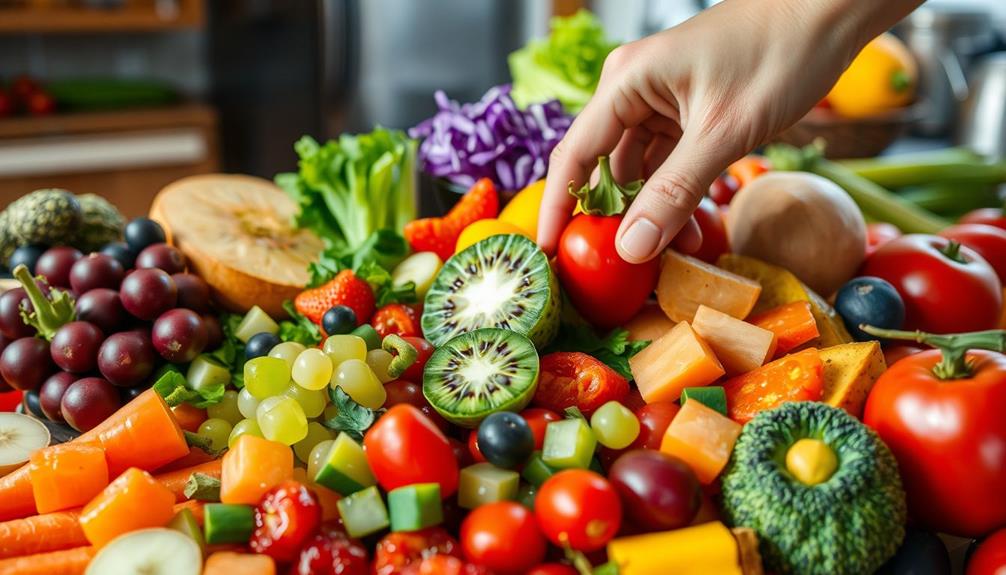
Food safety is a significant concern for anyone considering a raw food diet. While raw foods can be nutritious, they also pose risks, especially from harmful bacteria that can lead to foodborne illnesses.
Understanding common financial terms related to food safety can help you make informed decisions about your diet. Here are some essential tips to guarantee safe food handling:
- Wash all produce: Thoroughly clean fruits and vegetables to eliminate traces of harmful bacteria from contaminated produce.
- Handle raw animal products with care: If you're eating raw meat or eggs, verify they come from a reputable source and are stored correctly.
- Be cautious with sprouted seeds and nuts: These can harbor bacteria, and washing doesn't guarantee safety, so consider cooking them instead.
- Avoid raw flour: Consuming raw flour can expose you to E. coli; always cook flour-based products to confirm they're safe to eat.
Specific Dangers of Raw Ingredients
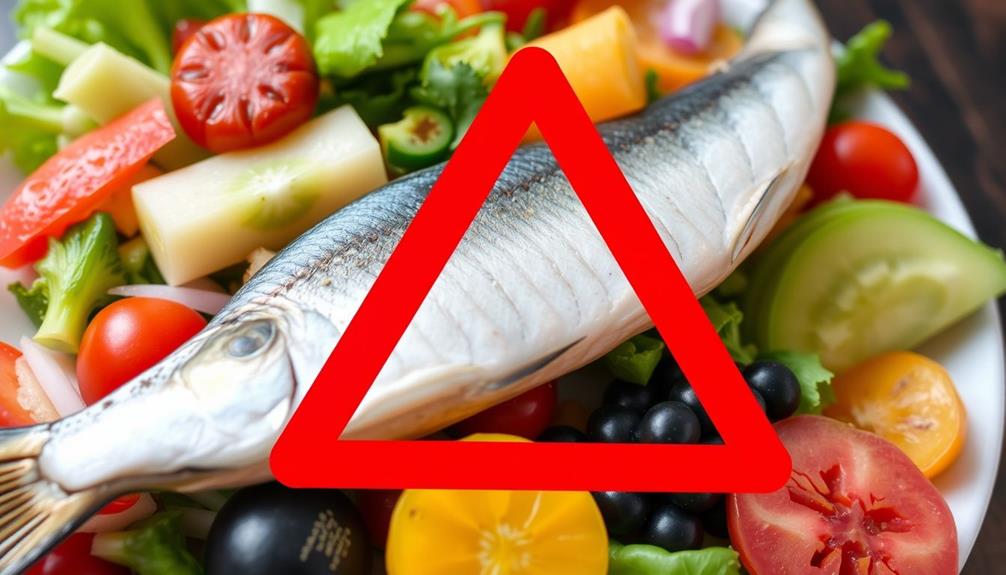
Many people underestimate the specific dangers associated with eating raw ingredients. While raw foods can be appealing for their health benefits, they can also harbor harmful bacteria like E. coli and Salmonella, which increase the risk of food poisoning. This is particularly concerning for high-risk groups, such as young children and pregnant women.
Individuals with conditions that affect their immune systems, such as those with Borderline Personality Disorder (BPD), may also be at heightened risk due to emotional dysregulation impacting their decision-making regarding food safety.
Raw meat poses significant dangers, especially if it's undercooked pork, which can carry dangerous bacteria. To guarantee safety, it must reach a minimum cooking temperature of 145°F with a resting time of three minutes.
Similarly, undercooked oysters can lead to serious infections like vibriosis and hepatitis A.
You should also be cautious with raw eggs and flour. Both can contain bacteria, making it unsafe to consume them uncooked, as seen in raw dough or batter.
Fish like swordfish and shark, often featured in sushi, can pose additional risks, as they may contain high mercury levels alongside potential bacteria and parasites.
Ultimately, while raw foods might seem healthy, understanding these specific dangers is essential for safeguarding your health.
Cooking Vs. Raw Food Nutrients
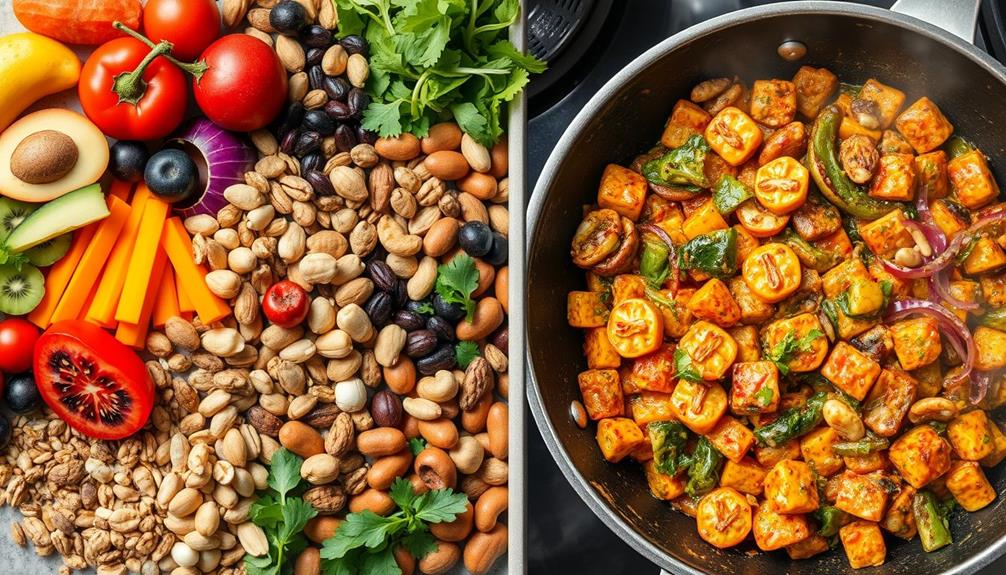
When it comes to nutrition, the debate between cooking and consuming raw foods often centers on nutrient availability. Cooked food can enhance the bioavailability of certain nutrients, making them more accessible. However, this process can also reduce the levels of sensitive nutrients, particularly water-soluble vitamins like vitamin C and B vitamins.
A raw food diet can also promote weight loss through low-calorie, high-fiber foods, which helps in maintaining a healthy weight and boosts energy levels from the natural enzymes present in raw foods, supporting overall health.
Here are some key points to reflect on:
- Nutrient Absorption: Cooking can increase the absorption of nutrients like lycopene in tomatoes and beta-carotene in carrots.
- Vitamin Loss: Heat-sensitive vitamins, such as vitamin C and B vitamins, can diminish considerably during cooking.
- Natural Enzymes: Raw foods retain their natural enzymes, which some believe aid digestion, though your body produces its own enzymes. Benefits of Raw Food
- Fiber Content: A raw food diet is typically high in fiber, promoting fullness, while cooking softens plant fibers for easier digestion.
Ultimately, both raw foods and cooked food offer distinct health effects, so it's crucial to strike a balance. Reflect on incorporating both methods into your diet to optimize your nutrient intake and enjoy a variety of flavors and textures!
Impact on Digestive Health
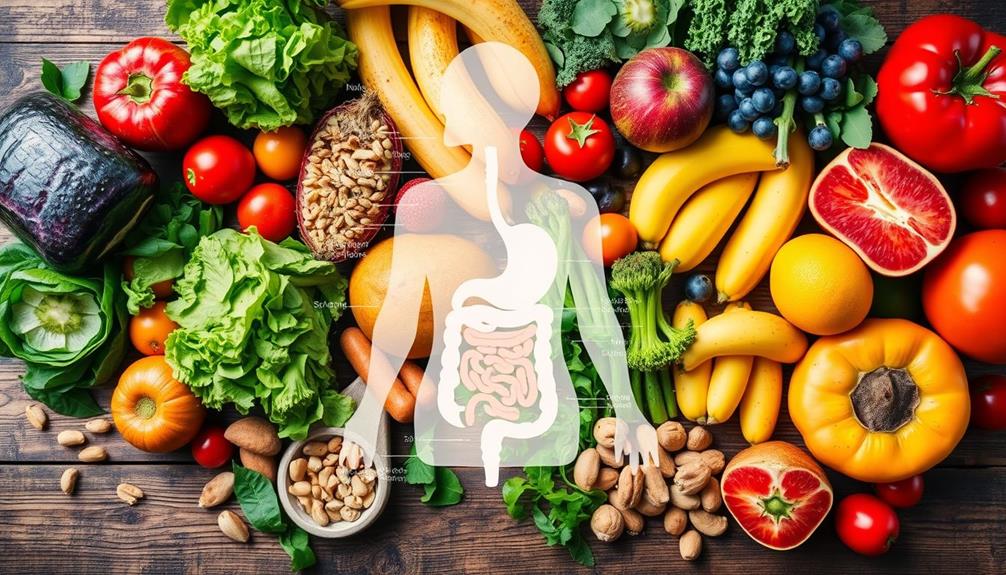
The impact of a raw food diet on digestive health can be significant, primarily due to its high fiber content. Eating raw foods, particularly raw fruits and vegetables, can promote regular bowel movements and help eliminate waste more effectively.
Additionally, raw foods often contain natural enzymes that may enhance nutrient absorption, making it easier for your body to utilize the vitamins and minerals present in your meals.
However, you might experience digestive discomfort, such as bloating or gas, especially if you consume large amounts of high-fiber raw fruits and vegetables. It's crucial to listen to your body and adjust your intake accordingly.
Moreover, while the raw food diet can be beneficial, it comes with some risks. The consumption of raw foods can increase the likelihood of foodborne illnesses, particularly from contaminated produce, which can negatively affect your digestive health through infections.
Lastly, it's significant to point out that cooking certain foods can reduce anti-nutrients, which can inhibit mineral absorption. As a result, some individuals on a raw food diet may experience lower mineral bioavailability, impacting their overall health.
Weight Management and Raw Foods
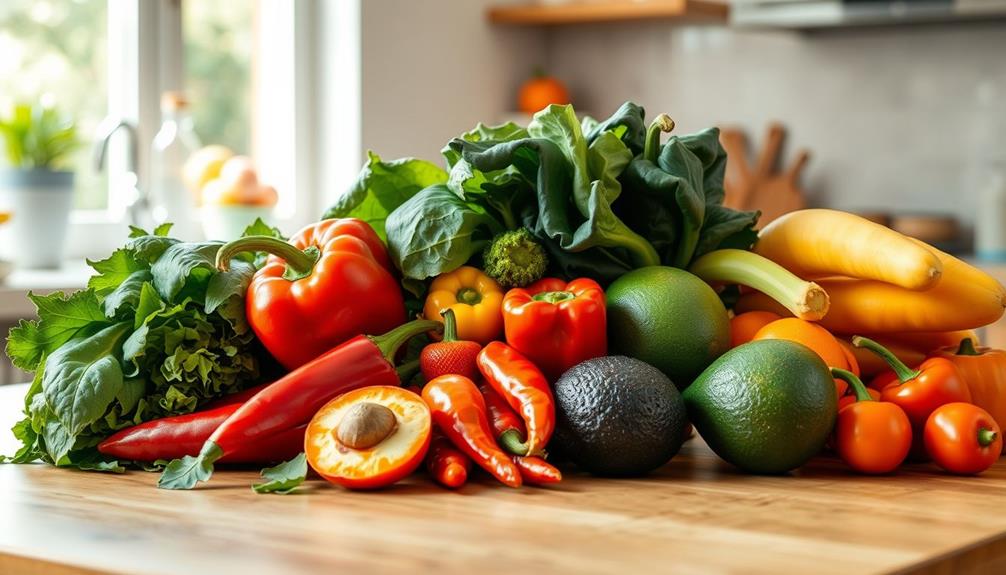
When you choose a raw food diet, you're likely to consume more nutrient-dense options while keeping your calorie intake in check.
The high fiber content in raw foods can boost your satiety, making it easier to feel full without overeating.
This combination can support your weight management goals effectively.
Nutrient Density Impact
Nutrient density plays an essential role in weight management, especially within the framework of a raw food diet. This diet typically emphasizes high fiber, low-calorie foods, which can help you feel full and satisfied.
By prioritizing nutrient-dense foods, you can reap several health benefits:
- Enhanced Satiety: High fiber content in fruits and vegetables promotes a sense of fullness, assisting in weight management.
- Reduced Risk of Chronic Diseases: The abundance of vitamins, minerals, and antioxidants may lower the risk of obesity-related diseases.
- Lower Cholesterol Levels: Studies suggest that a raw food diet can lead to decreased cholesterol and triglyceride levels, contributing to better cardiovascular health.
- Potential for Nutrient Deficiencies: While raw foods are rich in certain nutrients, strict adherence may limit your intake of protein and specific vitamins, which could negatively affect your metabolism.
Balancing the nutrient density of your meals is significant.
While processed foods may lack essential nutrients, focusing on a variety of raw foods can help you maintain a healthier weight and overall well-being.
Just remember to watch for any potential nutrient deficiencies that might arise.
Caloric Intake Reduction
Cutting back on calories is a key advantage of adopting a raw food diet, which focuses on fruits and vegetables that are naturally low in energy density. As you increase your intake of these foods, you'll likely find it easier to manage your caloric intake. This can lead to significant weight loss, with some individuals reporting reductions of up to 10% of body weight in short periods.
Here's a quick comparison of food types:
| Food Type | Caloric Density |
|---|---|
| Raw Fruits | Low |
| Processed Foods | High |
| Vegetables | Very Low |
The high fiber content in raw foods not only promotes health but also helps you feel full longer, which may reduce the urge to snack. By avoiding processed foods and added sugars, you'll consume fewer calories overall, aiding your weight management efforts. However, you must pay attention to meal planning to guarantee you meet your daily caloric needs while enjoying the benefits of a raw food diet. Balancing these aspects can lead to a healthier lifestyle while achieving your weight loss goals.
Fiber and Satiety
Eating a raw food diet not only helps you reduce caloric intake but also greatly boosts your fiber consumption. This increase in fiber is essential for effective weight management, enhancing satiety and helping you feel full longer.
Here are some key benefits of incorporating more raw foods into your diet:
- High Fiber Content: Raw fruits and vegetables are packed with fiber, aiding digestion and promoting a feeling of fullness.
- Low Calorie Density: These foods provide fewer calories per volume, allowing you to enjoy larger portions without exceeding your caloric needs.
- Stable Blood Sugar Levels: A high-fiber diet stabilizes blood sugar levels, reducing cravings and minimizing the risk of overeating.
- Improved Weight Loss Outcomes: Research shows that a fiber-rich diet, especially from raw foods, leads to better weight loss results and lower body fat percentage over time.
Meal Preparation for Raw Diet
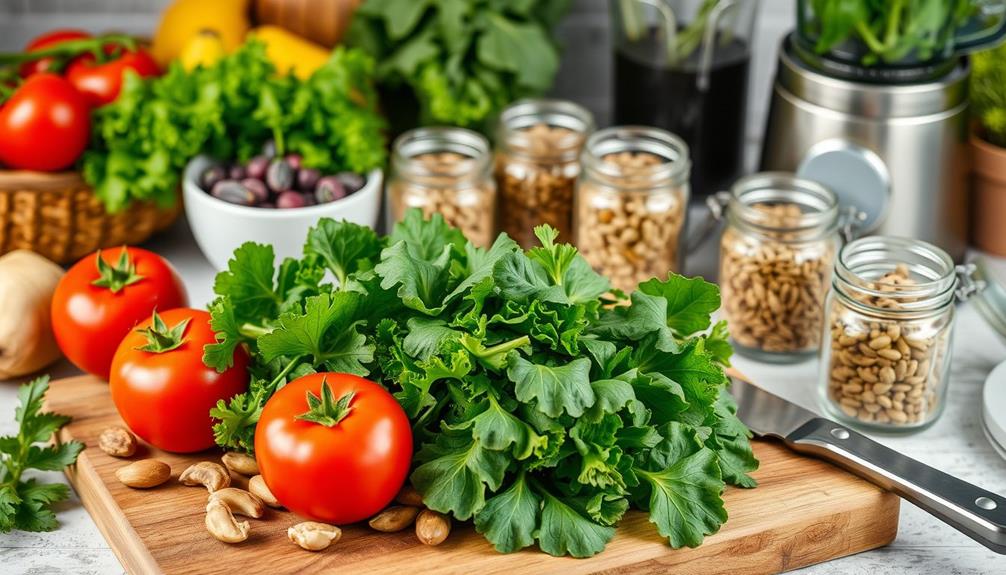
When diving into the world of a raw food diet, meal preparation becomes an integral part of your culinary journey. You'll want to master techniques like soaking, sprouting, dehydrating, juicing, blending, and chopping to guarantee your meals remain uncooked while retaining their natural enzymes and nutrients.
Soaking beans and grains is vital; it enhances digestibility and nutrient absorption, making your meals more satisfying.
Investing in a high-quality blender and food processor will facilitate your meal preparation, allowing you to whip up delicious smoothies, soups, and sauces that adhere to raw food principles.
To keep your meals exciting and nutritious, incorporate a variety of ingredients. Sticking to the same foods can lead to dietary boredom and increase the risk of nutrient deficiencies.
Make it a habit to shop for seasonal and local produce. This not only maximizes flavor and nutrition but also supports sustainable eating practices within your raw food diet.
Research on Raw Food Effects
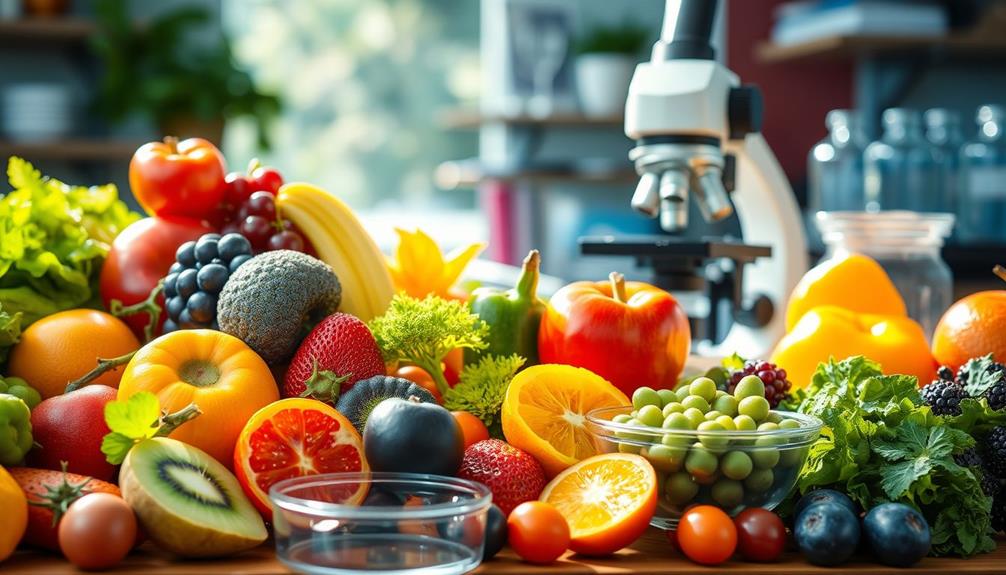
The raw food diet isn't just about meal preparation; it also brings a variety of health effects worth considering. Research indicates that while you may enjoy benefits, there are also significant risks associated with this lifestyle. Here are some key points:
- Chronic Diseases: Increased intake of fruits and vegetables can lower your risk of chronic diseases like heart disease and diabetes, thanks to higher levels of antioxidants and dietary fiber.
- Weight Loss: You might find that the lower calorie density of raw foods helps promote weight loss, as their higher fiber content keeps you feeling full longer.
- Nutrient Deficiencies: Long-term adherence to a raw food diet may lead to nutrient deficiencies, particularly in vitamin B12, iron, and omega-3 fatty acids. This can result in potential health issues.
- Bioavailability: Cooking methods can enhance the bioavailability of certain nutrients, such as lycopene and beta-carotene. Relying solely on raw foods might limit your nutrient absorption, suggesting a balanced approach may be more beneficial.
Understanding these effects can help you make informed choices about your diet.
Frequently Asked Questions
What Happens to Your Body When You Eat Raw Food?
When you eat raw food, your body absorbs more vitamins and minerals, boosting your energy. You might feel lighter due to high fiber content, but you could miss essential nutrients if you're not careful.
What Happens if You Eat Raw Food Everyday?
If you eat raw food every day, you'll feel like a superhero with boundless energy! But beware—nutrient deficiencies and foodborne illnesses lurk around the corner, so balance your diet for ideal health.
What Are the Negatives of the Raw Food Diet?
You might face nutrient deficiencies, digestive issues, and increased illness risks on a raw food diet. Limited variety can cause social isolation, and inadequate calories may disrupt your hormonal balance, making it hard to sustain long-term.
What Are the Dangers of Eating Raw?
Eating raw can expose you to harmful bacteria, increase your risk of foodborne illnesses, and lead to severe health issues from toxins. It's essential to understand these dangers before diving into a raw food lifestyle. Another potential risk of eating raw food is the potential for harmful parasites, such as tapeworms, to be present in uncooked meat and fish. Additionally, some raw fruits and vegetables can carry harmful pathogens on their surfaces, leading to foodborne illnesses. It’s important to weigh the potential health benefits against these risks when considering a raw food diet. In some extreme cases, prolonged consumption of raw food can even lead to strange side effects, such as eating raw food eye color change. Some people argue that the health benefits of raw food, such as increased nutrient intake and improved digestion, outweigh the potential risks. However, it’s crucial to approach a raw food diet cautiously and carefully, ensuring that the food is properly washed and prepared to minimize the risk of harmful bacteria and parasites. It may also be wise to consult with a healthcare professional or nutritionist before making significant dietary changes to ensure that you are meeting all of your nutritional needs. Ultimately, it’s essential to weigh the potential risks and benefits of a raw food diet before making a decision.
Conclusion
Eating raw food can be both invigorating and challenging. On one hand, you might feel energized by the vibrant nutrients packed in fresh fruits and veggies. On the other hand, you could risk nutritional deficiencies and foodborne illnesses if you're not careful. Balancing the benefits of increased energy with the potential dangers of raw ingredients is essential. If you embrace the raw food lifestyle mindfully, you can enjoy the rewards while minimizing the risks that come with it.
